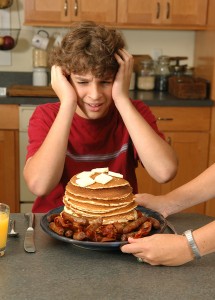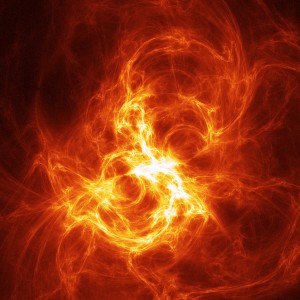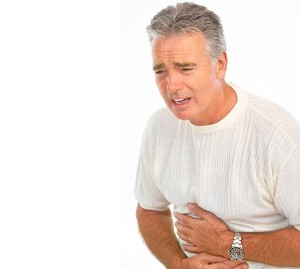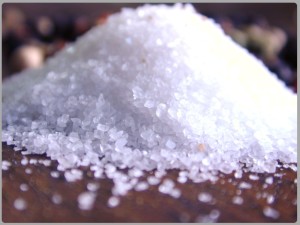Sources of Unexplained Fever
 Have you ever felt hot after eating and wondered why?
Have you ever felt hot after eating and wondered why?
It won't be possible to figure it out from a matter science medical approach but the understanding is clear from a energy science point of view
When overeating occurs(defined as consuming more than 2 handfuls at a meal) the energy patterns of Vata, Pitta, Kapha, or combinations of them enter the bloodstream and push stagnant energy along with them And there will always be some congestion when overeating occurs no matter which energy pattern is involved
From a molecular point of view stagnant energy is lymph or chyle that sludges in the lymphatics of the gut
The digestive fire(collective term for all the enzymes in the GI tract) becomes ramped up due to the overeating challenge and it also becomes disseminated into the blood as well resulting in fever and an internal feeling of heat This can also result in mental events such as anger and impatience
The timing of the fever is related to which energy pattern gets shoved into the blood stream Kapha soon after eating; Pitta about two hours after eating; Vata four hours after eating Which energy pattern is pushed into the bloodstream is based on the types of foods consumed in the overeating event For example if a lot of sweet, sour, and salty tastes are consumed, Pitta and Kapha symptoms will predominate
Kapha symptoms of overeating are congestion, runny nose, cold and cough
Pitta symptoms result in high fever, temporal headache, nausea, irritability, photophobia, and diarrhea
With the Vata energy pattern entering the blood stream, shivering, body ache, insomnia, and anxiety can occur These can leave a residual flu like syndrome that can last a few days
Have you ever overeaten? Have you recognized any of the above symptoms? Do you remember what produced the overeating?
Read More
10 Ways to Improve Agni
 In energy science work it's not just one thing that you do to bring about balance but a multiplicity of "things" And most of the time(80%) it's lifestyle behavior patterns not herbs and supplements that are the "things" that will make a difference This particularly plays out in digestive issues where attention to details pays big dividends
In energy science work it's not just one thing that you do to bring about balance but a multiplicity of "things" And most of the time(80%) it's lifestyle behavior patterns not herbs and supplements that are the "things" that will make a difference This particularly plays out in digestive issues where attention to details pays big dividends
This approach to disease brings clarity both emotionally and mentally so that better decision making is done as you move along in the process So let's take a look at some important choices that the energy science recommends to improve digestion
10 Energy Science Remedies for Poor Digestion
1 Biggest meal of the day at noon The digestive system is most ready for the experience between 11a and 2p Conversely at the same time at night between 11p and 2a one should be in bed or there is a great chance that you'll be "raiding the fridge" particularly if Pitta is high and the digestion is too hot
2 No snacking Snacking confuses the GI tract So eating the main meals at predetermined times every 4 hours is very important If you snack you will never know true hunger Due to its simple sugars that can be digested quickly fruit makes a perfect snack food
3 Only eat if real hunger exists The way to tell if there is true hunger is to drink some water and see if you're still hungry If your hunger goes away then it's false hunger However the best way to lock into true hunger is to eat at specific times of the day, eat the biggest meal of the day at noon, and don't snack
4 Ice is not nice Ice cools the GI tract down and agni The enzyme systems work best at 98.6F and so when ice is used during meals it affects your digestion and creates ama which is undigested, unprocessed food Ama is root of all disease so you can see that simply avoiding is a major step to improving your digestion
5 Pay attention to what you're doing and chew food thoroughly There is good experimental evidence to show that when you pay attention to the eating process you digest better There are estimates as to how many "chews" should be used for each mouthful of food and I think that a reasonable number is 20 This guideline is also useful for food prepartation paying attention to the food being prepared
6 Take your time eating Setting down your fork and chewing food, appreciating the taste, textures, and the completeness of chewing the food
7 Make a deal to sit while eating Sitting in your car while driving doesn't count here! Even if it's a grape make a deal with yourself that you'll sit down to eat the grape to create a habit
8 Don't eat when emotional upset Having mental and emotional turbulence prevents you from being able to focus on the process of eating at hand
9 Moderate exercise Make a point to do some form of exercise every day This improves agni and supports quality digestion and prevents ama formation The use of pranayama and in particular kapalabhati(KB) is an excellent way to improve agni and get exercise It may not seem like much but doing 5 minutes of KB is like running a half a mile
10 Use churans with meals At foodsheal.com under nutritional tools there is a listing of churans which are collections of spices that can be used during cooking or sprinkling on food before eating In the energy science each meal should have all 6 tastes Churans can be instrumental in providing these tastes in order to help improve digestion
Read More
5 Ways to Deal With Chronic Pain
 In the energy science of Ayurveda imbalance of qualities such as hot, cold, heavy, light affect the metabolic fire called agni When this happens the end result is a toxic morbid substance called ama This is essence is how disease occurs in the energy model discipline
In the energy science of Ayurveda imbalance of qualities such as hot, cold, heavy, light affect the metabolic fire called agni When this happens the end result is a toxic morbid substance called ama This is essence is how disease occurs in the energy model discipline
In chronic diseases the qualities lead to early symptoms of the disease complex but as progression occurs more qualities become involved and deeper tissues become affected due to the mounting amount of ama
Clogging of Energy Channels
When energy channels become obstructed with ama then there is no free flow of energy in the mindbody This leads to a buildup of the Vata energy pattern which is freely circulating in the channels(common channels we know from a Western perspective are the GI tract, large vessels like the aorta or vena cava, neural pathways, and the respiratory system)
Vata, when obstructed in the channels, causes pain In Ayurveda there is no pain without Vata So in the chronic disease pain is related to clogged channels from ama accumulation and the blockage of the free flow of Vata Often this is neurologic like pain and follows what I have written about in earlier blogs about the origin of any syndrome associated with pain
As you can see, keeping the channels open is essential for keeping vatagenic pain in check It is also important for immunity, and overall health To keep the channels open, it is important to eat fresh food with spices that help digestion so that ama is not formed When ama (partially digested food) is formed, its sticky nature blocks the channels and aggravates vata Also spices in your food, give a general warming effect to the whole body which helps to keep the channels open, and vata flowing
5 Ways to Prevent and Clear Pain
Staying warm The Vata energy pattern has the qualities of cold, light mobile, dry, rough, subtle, and clear so when we don't stay warm this can increase the Vata guna of cold and increase our pain Think about it....if you get cold the mindbody contracts Don't let your feet get cold Don't eat cold food and drink You might think ice cream is vata-pacifying because it's dairy but it's not It is actually vata-aggravating Anything cold you put in your system closes the channels and blocks the flow of vata That's why you get a headache if you eat cold things quickly
Transdermal creams can be used for pain control with reasonably good effect One has to be consistent, persistent, and disciplined in their use but if applied properly they can be very effective
Nutrition that causes pain Large beans, bananas, winter squashes and extra heavy foods are all known in Ayurveda as visthambi, (clogging to the srotas or channels) Avoid these items in your diet and you will find your channels are more open, and your vatagenic pain is less Also, avoid the nightshades (potatoes, tomatoes, bell peppers, eggplant) because these toxic plants block the vibrational channels (nadis), which can subsequently cause the physical channels (srotas or channels) to shrink
Avoiding leftover foods or pre-packaged foods is important too These foods are not easily digested by the body and result in ama right away This promotes clogging of the channels and lessen the free flow of Vata
Daily schedules Regular routine is Vata pacifying so daily schedules are irregular and hectic(Vata provoking) there will be a tendency to increase the Vata energy pattern
Read More
“I Think I’ll Order the Inflammation Today”

 As I muse through the menu at my favorite restaurant, I can hear myself in the process of selection
As I muse through the menu at my favorite restaurant, I can hear myself in the process of selection
"Hmmm, this looks particularly good-lots of congestion and inflammation there"
"Or maybe some cooling? Oh no no, that's not tasty enough"
"Well maybe just this time"
From an energy science view, the effects of the foods that we consume begin before we even put them in our mouths Does that sound surprising?
Our unconscious behavioral eating patterns begin in the mind so it makes sense that the health of our mindbodies bedome directed by our unconscious choices
This concept is so far removed from our current matter science or molecular approach which is devoid of being able to factor the mind in the equation of foods and their selection
Let's pause and consider that whatever we are putting in our mouths at any point in time has the ability to make us sick or bring about balance
We currently don't have the concept from our matter science model of healing that disease begins with the ingestion of taste(energy) If I'm a PK and snarfing down a banana I'm inflamming my physiology and asking for congestion
And is it wrong to have a banana? No, not from an energy science view The key as we have discussed in the past is to be aware of how the foods impact us from a sensory point of view
We intellectualize about foods from a matter science view but from an energy science view the ingestion of any food has the capability of teaching us more about ourselves
Have you had the experience of food making you feel bad? Did this become a recurring theme? Did it take a number of days before the ingestion of a particular food made you feel bad?
Read More
Eating Challenges and the Holidays
 Food selection may become a big deal during the holidays with those with eating challenges So what are some techniques that can help during the holidays? Spreading out holiday-related events, and making get-togethers, and more activity are just a few ways to stay healthy this season
Food selection may become a big deal during the holidays with those with eating challenges So what are some techniques that can help during the holidays? Spreading out holiday-related events, and making get-togethers, and more activity are just a few ways to stay healthy this season
Spread Out Your Events
Try to spread out the parties and get-togethers, instead of visiting several households on the same day If there is an event where the cooking is shared, start a Facebook group page to better organize the dinner and ensure there are plenty of healthy options Each member can discuss what they are bringing to allow a wide variety of colors and choices rather than an overload of starches. You can also use this page to share recipes
Move at the Party
Holiday gatherings often consist of sitting, eating, talking, drinking, and more eating We often find ourselves sitting for longer periods of time because we enjoy the conversation Your legs want to move, the food is on the counter, and off you go for food you’re are not even hungry for This year, try some of these actions with the family to reduce the march to the kitchen Take a walk or try some other physical activity
Don't Go Overboard
Sticking to a healthy plan is important However depriving yourself of certain foods can have negative results Restrictive eating can lead to binge eating as well as disliking healthy foods by associating them with something you ‘have’ to do When it’s time to pile food on your plate, eat what visually appeals to you, or you know you love without guilt clouding the mind Try these final tips for holiday eating If smaller plates are an option, use them. You’ll fill larger plates just because room is available. Second trips are better than overeating on the first round If you’re trying something new, only take a bite-size portion
As you begin to incorporate more healthy practices into your life—whether during the holidays or during everyday life—your mindset will start to shift, and you’ll begin to not only choose more nutritious foods, but actually enjoy them, too
Read More
The Salty Taste: 5 Ways to Avoid Inflammation
 The energy science categorizes food according to taste(rasa which has an effect on the energy patterns of VPK), virya(effect that food has on our small intestine and tissues), vipak(effect that food has on our colon and cells), and prabhav(effect that it has on the DNA of our cells) This makes the interpretation of how foods affect us quite complex and explains why the nutritional formats at foodsheal.com are useful because they simplify our understanding of foods and allow us to make healthy balancing food choices that help treat disease states
The energy science categorizes food according to taste(rasa which has an effect on the energy patterns of VPK), virya(effect that food has on our small intestine and tissues), vipak(effect that food has on our colon and cells), and prabhav(effect that it has on the DNA of our cells) This makes the interpretation of how foods affect us quite complex and explains why the nutritional formats at foodsheal.com are useful because they simplify our understanding of foods and allow us to make healthy balancing food choices that help treat disease states
To recall the qualities of Vata(cold, light, mobile, dry, rough, subtle, clear) and Pitta(hot, light, spreading, sharp/penetrating, liquid, oily) and Kapha(heavy, slow/dull, cool, slimy/smooth, liquid, dense, soft, hard, static, sticky) give rise to disease in the mindbody These qualities combine in various combinations to produce the diseases due to their physiologic excess
The key to understanding the energy science disease model is to begin to appreciate the imbalance in qualities that occur in the mindbody physiology and how you bring about the imbalance As we have discussed in the past the primary way we go out of balance is through foods
The Unique Salty Taste
The energy science of Ayurveda recognizes that there are 6 tastes called rasas(sweet, sour, salty, pungent, bitter, and astringent) that allow us to scientifically study foods and their intimate impact on the mindbody energy field These tastes are typically in combination with one another in foods For example, seafood(meat that has lived its life in saltwater) has a salty rasa or taste energtically even though it doesn't taste salty Due to protein of the meat it has a heating vipak, and the dense and heavy qualities of seafood produce the sweet taste as the vipak energetic influence
Aside from seafood, mineral salts such as sea salt or table salt and surprisingly cottage cheese are the only ways we encounter the salty taste in foods so the salty taste becomes our first encounter with the concept of a "culinary spice"salty cottage cheese
The qualities of the salty taste are hot, light, liquid, soft, smooth/slimy, and subtle From the above qualities of Vata we can appreciate that the mobile quality will be reduced by the slimy/smooth quality of salt but Pitta will be increased due to the hot quality Because the salty taste carries the hot quality it will be aggravating to people with high Pitta
Due to the hot quality salt produces inflammation and due to the liquid quality it produces its well known congestive effect with fluid retention
Since rasa(taste) has an influence on our mindbody through the qualities of the foods that we take in, if we get an excess of the salty taste it can produce with the hot and liquid qualities, impatience, irritability, and easy frustration
As advertised in potato chip commercials, "Bet you can't each just one", implies that the salty taste can be addictive This addictive like characteristic of salt is why ALL fast food chains use a lot of the salty taste in their food preparation
Due to salt's penetrating and hot qualities it can be very effective in massaging and warming muscles and so soaking in epsom salt baths becomes valuable Another use of salt is with neti sinus wash that reduces Kapha mucous in the sinuses where it accumulates This is the experience everyone has with the common cold Neti uses a salt solution since tap water will burn the delicate mucous membranes But salt also is important in mobilizing with its hot quality the cool, slimy/smooth, liquid, heavy, dense, slow/dull, and static qualities of Kapha which are those of mucous
5 Takeaways About the Salty Taste
When it comes to high Pitta disorders(anything with inflammation) there are some basic things to remember when it comes to the salty taste
Avoid salt at the dinner table
Avoid all seafood Eat fresh water fish
Avoid all fast food
Avoid salt in food preparation at home
Avoid cottage cheese
Read More




